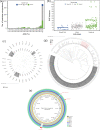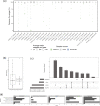Detailed mapping of Bifidobacterium strain transmission from mother to infant via a dual culture-based and metagenomic approach
- PMID: 37230981
- PMCID: PMC10213049
- DOI: 10.1038/s41467-023-38694-0
Detailed mapping of Bifidobacterium strain transmission from mother to infant via a dual culture-based and metagenomic approach
Abstract
A significant proportion of the infant gut microbiome is considered to be acquired from the mother during and after birth. Thus begins a lifelong and dynamic relationship with microbes that has an enduring impact on host health. Based on a cohort of 135 mother-infant (F = 72, M = 63) dyads (MicrobeMom: ISRCTN53023014), we investigated the phenomenon of microbial strain transfer, with a particular emphasis on the use of a combined metagenomic-culture-based approach to determine the frequency of strain transfer involving members of the genus Bifidobacterium, including species/strains present at low relative abundance. From the isolation and genome sequencing of over 449 bifidobacterial strains, we validate and augment metagenomics-based evidence to reveal strain transfer in almost 50% of dyads. Factors important in strain transfer include vaginal birth, spontaneous rupture of amniotic membranes, and avoidance of intrapartum antibiotics. Importantly, we reveal that several transfer events are uniquely detected employing either cultivation or metagenomic sequencing, highlighting the requirement for a dual approach to obtain an in-depth insight into this transfer process.
© 2023. The Author(s).
Conflict of interest statement
D.G. is an employee of PrecisionBiotics Ltd (Novozyme Cork) who sponsored the clinical study. All other authors declare no competing interests.
Figures





References
-
- Coker, M. O. & Madan, J. C. The microbiome and immune system development. In The Developing Microbiome (INC, 2020). 10.1016/b978-0-12-820602-7.00003-9.
Publication types
MeSH terms
LinkOut - more resources
Full Text Sources
Other Literature Sources

